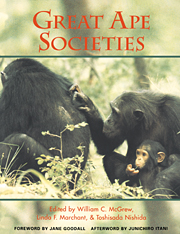Book contents
- Frontmatter
- Contents
- List of contributors
- Preface
- Foreword: conserving great apes
- Part I Apes overviewed
- Part II Social ecology
- 4 Social ecology of Kanyawara chimpanzees: implications for understanding the costs of great ape groups
- 5 Ranging and social structure of lowland gorillas in the Lopé Reserve, Gabon
- 6 Sympatric chimpanzees and gorillas in the Ndoki Forest, Congo
- 7 Dietary and ranging overlap in sympatric gorillas and chimpanzees in Kahuzi-Biega National Park, Zaïre
- Part III Social relations
- Part IV Minds
- Part V Apes compared
- Part VI Modeling ourselves
- Afterword: a new milestone in great ape research
- Appendix: great ape study sites
- Index
6 - Sympatric chimpanzees and gorillas in the Ndoki Forest, Congo
Published online by Cambridge University Press: 04 August 2010
- Frontmatter
- Contents
- List of contributors
- Preface
- Foreword: conserving great apes
- Part I Apes overviewed
- Part II Social ecology
- 4 Social ecology of Kanyawara chimpanzees: implications for understanding the costs of great ape groups
- 5 Ranging and social structure of lowland gorillas in the Lopé Reserve, Gabon
- 6 Sympatric chimpanzees and gorillas in the Ndoki Forest, Congo
- 7 Dietary and ranging overlap in sympatric gorillas and chimpanzees in Kahuzi-Biega National Park, Zaïre
- Part III Social relations
- Part IV Minds
- Part V Apes compared
- Part VI Modeling ourselves
- Afterword: a new milestone in great ape research
- Appendix: great ape study sites
- Index
Summary
INTRODUCTION
After the pioneering study of sympatric western lowland gorillas (Gorilla gorilla gorilla) and tschego chimpanzees (Pan troglodytes troglodytes) in Rio Muni (Equatorial Guinea) by Jones & Sabater Pi (1971), several study sites were established in the 1980s in tropical forests where both chimpanzees and gorillas occur (western lowland gorillas and tschego chimpanzees – Gabon: Tutin & Fernandez, 1984, 1993; Tutin et al., 1991; Tutin, Chapter 5; Central African Republic: Carroll, 1988; Fay, 1988; Remis, 1993, 1994; Congo: Kuroda, 1992; Nishihara, 1992, 1994; Mitani et al., 1993; eastern lowland gorillas (Gorilla gorilla graueri) and long-haired chimpanzees (Pan troglodytes schweinfurthii) eastern Zaïre: Yamagiwa et al., 1992, 1994, Chapter 7).
Recent studies at these sites suggest common features of interspecific relationships between gorillas and chimpanzees. Generally, dietary overlap in plant food is great, ranging from about 50% at Kahuzi-Biega (Yamagiwa et al., 1994) to 60–80% at Lopé (Williamson et al., 1990; Tutin & Fernandez, 1993) and Ndoki (Kuroda, 1992). Overlap in fruit consumption is particularity high (70–90%) and habitat use patterns are similar. Thus, they share a similar niche and ecological competition is likely to occur between these two ape species (Tutin & Fernandez, 1985, 1993; Williamson et al., 1990; Kuroda, 1992). Low population densities of gorillas and chimpanzees in Lopé and Kahuzi-Biega might partly be due to this competition (Tutin & Fernandez, 1985; Yamagiwa et al., 1992).
- Type
- Chapter
- Information
- Great Ape Societies , pp. 71 - 81Publisher: Cambridge University PressPrint publication year: 1996
- 93
- Cited by

